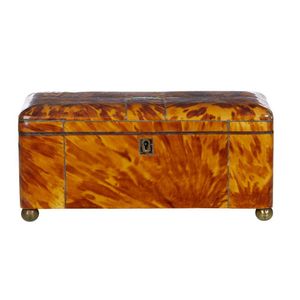Tortoiseshell Teacaddy with Silver Stringing and Gilt Brass Feet
An early 19th century tortoiseshell teacaddy, of plain design with silver stringing and gilt brass ball feet, the interior fitted in rosewood and tortoiseshell with two lidded compartments and a glass mixing bowl. English circa 1820. 12 x 25 x 15 cm
You must be a subscriber, and be logged in to view price and dealer details.
Subscribe Now to view actual auction price for this item
When you subscribe, you have the option of setting the currency in which to display prices to $Au, $US, $NZ or Stg.
This item has been sold, and the description, image and price are for reference purposes only.
- Rosewood - A dense timber that varies in shade to very light brown to almost black. When rosewood is cut and sanded the colour of the timber will turn black, and after polishing and exposure to daylight, the surface will gradually lighten over time to light brown with black streaks.
The name comes from the odour emanating from the timber when it is planed, sanded or cut.
Rosewood was very popular for use in Victorian furniture in the second half of the 19th century, and at that time most of the rosewood was imported from Brazil. However it also grows in India and Indonesia.
It is used in the sold for chairs and table legs, but for carcase furniture such as side cabinets and bookcases, and for table tops it is always used as a veneer. - Circa - A Latin term meaning 'about', often used in the antique trade to give an approximate date for the piece, usually considered to be five years on either side of the circa year. Thus, circa 1900 means the piece was made about 1900, probably between 1895 and 1905. The expression is sometimes abbreviated to c.1900.
- Tortoiseshell - Tortoiseshell is a translucent material that comes from the horny carapace of a certain types of turtles, including the hawksbill turtle. It is often therefore mounted on a colour underground - often red - or inlaid with gold or silver thread, as seen in Boulle furniture.
The texture and colour nuances of the material are extremely important. Heated tortoiseshell can easily be formed into various shapes. Like other natural materials, tortoiseshell becomes more beautiful with use. In a time before plastic, tortoiseshell was widely used for small objects such as combs and powder compacts.
In 1973, the trade of tortoiseshell worldwide was banned under CITES (The Convention on International Trade in Endangered Species). Prior to importing or exporting items containing tortoiseshell a CITES permit must be obtained. Tortoiseshell items cannot be traded on Ebay.
"Faux tortoiseshell", another case of man initiating nature, is made from old-style plastics such as celluloid and cellulos and is coloured with red, yellow and brown spots to imitate the genuine article. It is commonly used in glasses frames, musical instruments and costume jewellery.
This item has been included into following indexes:
-
tea caddies, material
- rosewood 152
- tortoiseshell 71
- tea caddies, period or age - Georgian 327
Visually similar items

A Victorian bangle, sterling silver, B&C, Birmingham 1882. Diameter 6 cm. Weight 43.7g
Sold by
in
for
You can display prices in $Au, $US, $NZ or Stg.

An 18ct yellow and white gold wedding band. Size J. Weight 1.7g.
Sold by
in
for
You can display prices in $Au, $US, $NZ or Stg.

Tibetan bronze buddha statue, late 19th century. 15 cm.
Sold by
in
for
You can display prices in $Au, $US, $NZ or Stg.

Edwardian seed pearl & garnet filigree pendant. Gold content untested; plated chain. Two pearls missing
Sold by
in
for
You can display prices in $Au, $US, $NZ or Stg.
